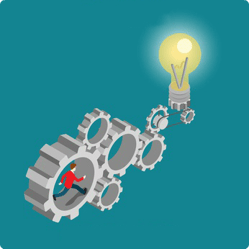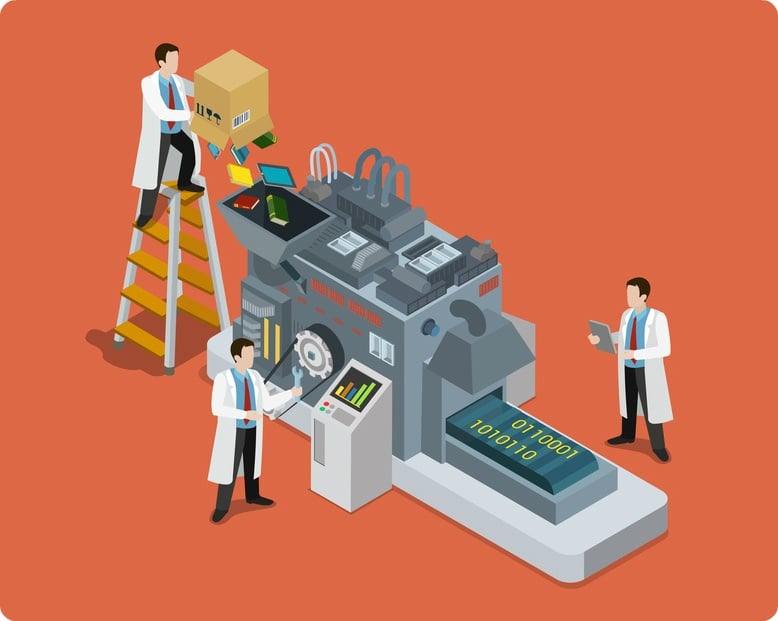Technology has led us to put many parts of our lives on autopilot. We have recurring subscriptions to services, we use the smart devices to remind us to do things like call someone for their birthday or exercise, and we use the internet to deliver us the information we need when we need it. All of this has the potential to improve our lives as long as we use this convenience to pursue greater things.
B2B marketing is equal parts attentiveness to your prospects—their traits, needs and concerns—and grinding out routine actions to maintain a useful presence. B2B automation strategies aim to take the grind out of the latter, allowing a marketing department to allocate more focus on learning about what resonates with their ideal prospects. However, automating aspects of your inbound strategy isn’t about setting and forgetting—it only works well when appended with a manual effort to be even more attentive.

If you’re one of the 45 percent of B2B companies not yet using some form of marketing automation, it’s time to think about utilizing it.
In recent years, automation techniques have moved from the sole realm of large enterprises to becoming a feasible addition for small to mid-sized businesses ($50-$500 million). Solutions are more affordable and available while the benefits they provide are increasingly more relevant for all companies, not just the big fish.
If you’re one of the 45 percent of B2B companies not yet using some form of marketing automation, it’s time to think about utilizing it. Here’s a simple rundown of B2B inbound automation’s benefits for businesses of any size:
Easily personalize targeting
B2B marketing success hinges on speaking to the subset of prospects your solutions are most relevant to, not just shouting at the entire crowd of buyers. Segmenting buyers into ideal and lesser prospects is an important first step in creating more detailed buyer personas.
 The best thing about having well-thought out profiles of ideals buyers on the whole, and the decision-makers within them, is knowing what content you need to create for them specifically. A lot of content marketing actions fit the form of if-then statements—for example, if an awareness-stage prospect is looking for a solution, then create content which helps them understand more about their problem and how to solve it. Anticipating the buyer’s needs makes them feel that you’ve done your homework.
The best thing about having well-thought out profiles of ideals buyers on the whole, and the decision-makers within them, is knowing what content you need to create for them specifically. A lot of content marketing actions fit the form of if-then statements—for example, if an awareness-stage prospect is looking for a solution, then create content which helps them understand more about their problem and how to solve it. Anticipating the buyer’s needs makes them feel that you’ve done your homework.
In the same manner, automation allows for an easy way to send that relevant content to the right folks based on context. Use the information leads give you—the size of their company, their position in it, and the reason they’re offering their contact information, to name a few items—and earmark content to be sent for the various categories. That way, from the moment they sign up for email interactions, they are getting information targeted to address their needs.
Create a journey within the journey
Through that specific targeting, you can carve out different, personalized routes for different decision-makers within a buyer’s company or for different types of buyers on the whole. The purchasing journey is not identical for all B2B buyers and how you get a lead from awareness to decision depends on the feedback they give, directly or indirectly.
Taking a little more time to set up separate automated paths, segmented for details beyond basic firmographics (such as corporate culture, proclivity towards investing in innovation, or their previous experience with the solutions you provide) build a better relationship with buyers early on. This way, you display an attentiveness to the diversity of B2B buyer needs and an ability to address them all in a comprehensive and timely manner.
Identify the best of the best
Beyond sending emails, offers or content based on context, automation also can apply to evaluating the quality and interest of leads as they pass certain checkpoints in the purchasing journey. Lead scoring can be done efficiently and effectively, as your platform grades the responses which leads have to your various communications. By plugging your calls-to-action, offers and analytics into an automation platform, you glean hard data about your conversion rates between each point in the buyer’s journey.

The results of your marketing automation will tell you many things, like whether you’re using too light or too heavy a touch with leads.
The benefit here is twofold. First, it can paint a clearer picture of the types of buyers your company should be perusing by showing how your current efforts are resonating with leads and for whom they’re most effective. Second, it can highlight points where the interactions you’re having with leads aren’t quite hitting home and, thus, need to reanalyzed.
Use results to improve
That second point is an important supplemental benefit of inbound automation. Employing an automation platform isn’t the end of tinkering with your strategy—rather, it’s the beginning of a period of more assured and certain improvement.
The results of your marketing automation will tell you many things, like whether you’re using too light or too heavy a touch with leads, if you’re really focusing on the issues buyers themselves are focused, and whether you’re moving leads along the purchasing journey or just dumping information on them without properly motivating forward movement.
With these focal points in mind for deploying B2B marketing automation, any business can improve its conversion rates. This tool gives you the ability to reliably take care of fundamentals in lead-nurturing (providing content and an ability for buyers to reach out to you for more) so as to focus better on the details that create a truly winning marketing strategy.
B2B marketing is dichotomous—at the top of the funnel it is a bit more of a numbers game, but further along it becomes about genuine trust and relationship-building. Marketing automation serves to enhance your manual efforts to give B2B buyers the knowledge, assurance and communication they need to make a confident purchase from your business. And the automation shouldn’t stop at the arrival of a sales qualified lead. Consider sales automation by identifying and connecting the next steps in your company’s sales process to the automation tools. ![]()







 By
By 